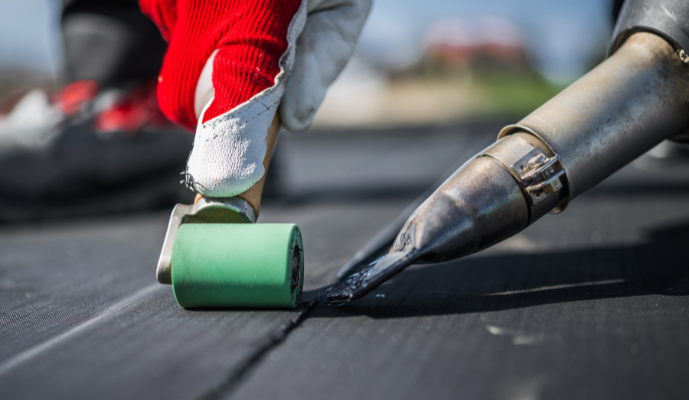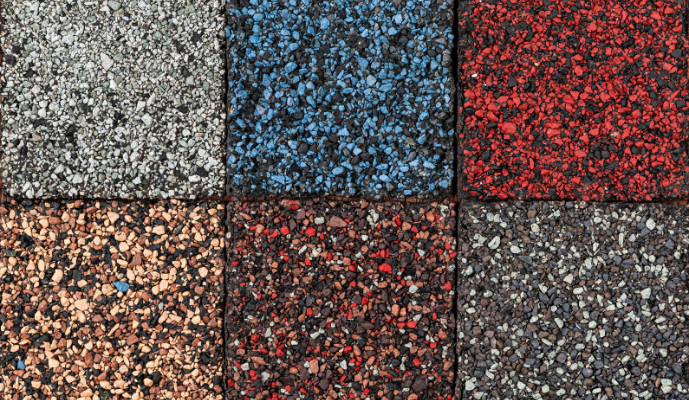Flat roofs, known for their minimalistic design and cost efficiency, are a popular choice of roof material for both residential and commercial buildings. Selecting the right roofing products for flat roofs is crucial to ensure longevity and protection against harsh weather conditions. In this guide, we’ll explore the best flat roof materials, their benefits, and how they can provide the durability and weather resistance needed for your roofing project.
Understanding Flat Roof Systems
Flat roof systems offer a sleek and modern aesthetic, but they come with unique challenges. These roofs are more prone to water pooling, which can lead to leaks and damage. Therefore, selecting the right flat roofing materials is essential for maintaining a solid and reliable flat roof membrane and surface.
Built-Up Roofing (BUR)
Built-up roofing, often referred to as BUR is one of the oldest and most reliable flat roofing systems. It consists of multiple layers of asphalt and reinforcing fabrics, creating a durable fire fire-resistant, and waterproof barrier. BUR is favored for its excellent protection against water and UV radiation, making it a long-lasting choice for flat roofs.
Benefits of Built-Up Roofs:
-
Exceptional durability
-
Excellent waterproofing
-
UV protection
-
Cost-effective for large areas
Modified Bitumen
Modified bitumen roofs are a popular choice due to their flexibility and robustness. This roofing material combines traditional asphalt with polymerized rubber or plastic, enhancing its performance in extreme temperatures. Modified bitumen roofs can be installed using heat-welding, cold-applied adhesive, or self-adhering sheets, offering versatility in application.
Advantages of Modified Bitumen Roofs:
-
High tensile strength
-
Resistant to extreme temperatures
-
Easy to repair
-
Multiple installation methods
Single-Ply Membranes
Single-ply membranes are another effective solution for flat roofs, known for their ease of installation proper maintenance, and strong weather resistance. There are two primary types of single-ply membranes: EPDM and TPO.
EPDM (Ethylene Propylene Diene Monomer)
EPDM is a synthetic rubber roofing membrane widely used in low-slope roofs. It is renowned for its durability, flexibility, and resistance to harsh weather conditions. EPDM roofs are also environmentally friendly, often made from recycled materials.
EPDM Roof Benefits:
-
Long lifespan (up to 30 years)
-
Excellent UV resistance
-
Environmentally friendly
-
Easy to install and repair

TPO (Thermoplastic Olefin)
TPO roofing membranes are a relatively new but highly effective flat roofing material. TPO the roof membrane is known for its energy efficiency, thanks to its reflective surface that helps reduce cooling costs. It is also resistant to punctures, chemicals, and UV radiation.
TPO Roof Advantages:
-
Energy-efficient
-
High resistance to punctures and chemicals
-
Lightweight and flexible
-
Easy to install
Standing Seam Metal Roofs
While standing seam metal roofs are often associated with pitched roofs, they can also be used for flat roofs, providing a sleek, modern appearance along with outstanding durability. These roofs consist of interlocking metal panels that offer superior protection against leaks and harsh weather.
Benefits of Standing Seam Metal Roofs:
-
Long lifespan (up to 50 years)
-
Excellent weather resistance
-
Low maintenance
-
Aesthetic appeal
Asphalt Shingles
Asphalt shingles are more commonly used on pitched roofs but can be adapted for low-slope roofs. They are affordable, easy to install, and available in a variety of styles and colors. However, they may require additional waterproofing measures to ensure their effectiveness on flat roofs.
Advantages of Asphalt Shingles:
-
Cost-effective
-
Easy to install
-
Variety of styles and colors
-
Good performance with proper installation

Liquid Applied Roofing
Liquid-applied roofing systems offer a seamless, flexible, and highly durable solution for flat roofs. These systems involve applying a liquid coating that cures to form a tough, waterproof, membrane roof. They are ideal for roofs with complex geometries and can be used for both new installations and repairs.
Key Benefits of Liquid Applied Roofing:
-
Seamless and flexible
-
Excellent waterproofing
-
Easy to apply on complex surfaces
-
Suitable for repairs and new roofs
Choosing the Best Flat Roofing Material
Selecting the best flat roofing material depends on various factors, including the specific needs of your flat roof material,, budget, and climate conditions. Here are some common flat roof materials and their key attributes to help you make an informed decision:
Built-Up Roofing (BUR)
Built-up roofing remains a reliable choice for those seeking proven durability and weather resistance. Its multiple layers provide robust protection, making it suitable for a range of applications.
Modified Bitumen
Modified bitumen offers a balance of strength and flexibility, performing well in various temperatures and weather conditions. Its ease of repair and multiple installation options make it a versatile choice.
Single-Ply Membranes
Single-ply membranes like EPDM and TPO are favored for their simplicity and effectiveness. They offer excellent resistance to UV rays, chemicals, and punctures, ensuring a long lifespan.
Standing Seam Metal Roofs
For those looking for a modern and long-lasting roof replacement solution, standing seam metal roofs provide exceptional durability and low maintenance. Their sleek appearance adds aesthetic value while protecting against severe weather.
Asphalt Shingles
Asphalt shingles can be a viable option for low-slope roofs, offering affordability and ease of installation. Ensure proper waterproofing measures to maximize their performance on flat surfaces.
Liquid Applied Roofing
Liquid-applied roofing is ideal for roofs with complex shapes and for those seeking a seamless, waterproof membrane built-up roof side. Its flexibility and strong adhesion make it suitable for various applications.

Maintenance Tips for Flat Roofs
Maintaining flat roofs is crucial for prolonging their lifespan and ensuring they remain weather-resistant. Here are some essential maintenance tips:
-
Regular Inspections: Conduct regular inspections to identify and address issues early.
-
Clean the Roof Surface: Remove debris, leaves, and standing water to prevent damage.
-
Check for Leaks: Look for signs of leaks or water damage and repair promptly.
-
Maintain Flashings and Seals: Ensure flashings and seals are intact and in good condition.
-
Professional Maintenance: Hire a roofing professional for regular maintenance and inspections.
Conclusion
Choosing the right roofing products for flat roofs is essential for ensuring durability and weather resistance. From built-up roofing and a modified bitumen roof to single-ply membranes and standing seam metal roofs, each material offers unique benefits tailored to different needs and budgets. Regular maintenance and professional inspections further enhance the longevity and performance of your flat roof.
At Roof Design Naples, we provide comprehensive roofing services tailored to meet your specific needs. Our team of experienced professionals is dedicated to delivering high-quality commercial roofing solutions, ensuring your flat roof remains durable and weather-resistant for years to come. Contact us today to learn more about our services and how we can help with your next roofing project.

